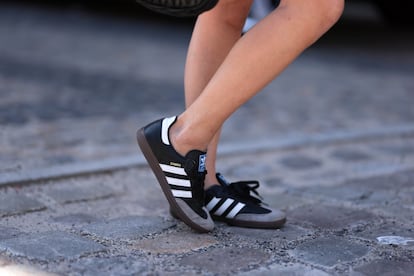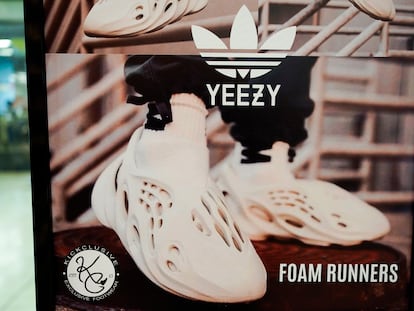How the Samba saved Adidas after the Kanye West fiasco
The success of these sneakers, whose original model dates back to 1950, has partially compensated the athletic apparel and footwear company for the hole in its finances caused by the fiasco of collaborating with the American rapper

Few at Adidas could have foreseen that sneakers whose original model was launched for the 1950 FIFA World Cup would manage to fill the hole left in the brand’s finances by the termination of its most modern and groundbreaking collaboration. But fashion is fickle. The sportswear company is managing to leave behind Yeezy, its lucrative collaboration with rapper Kanye West — now known as Ye — thanks to the gradual reduction of its remaining inventory and, above all, the pull of its “originals” models, like the Samba. Although its profits are shrinking, the forecasts of losses of up to $765 million that it made at the beginning of the year are now a thing of the past. The German company is currently managing to convince the markets that it has overcome the slump.
In the first nine months of this year, the footwear and sports equipment firm made a profit of $332 million, 72% less than in the same period of 2022. Although these figures reflect an obvious slowdown in its business, they are better than expected. The company managed to increase its margin and dispose of the inventory that it had been burdened with in recent months. In the statement accompanying the results, presented at the beginning of November by CEO, Bjørn Gulden — who came to Adidas at the end of last year to revive the sports brand’s fortunes after working for Puma, Adidas’ bitter rival since 1948 — pointed directly to the “heat” generated around the lifestyle models such as Samba, Gazelle, and Spezial as one of the pillars of its business this year.
The “heat” for these Adidas models is easily verifiable on the street, whether on Serrano Street in Madrid or on the Champs Elysées in Paris. But the reasons why, like everything in this industry, are more difficult to locate. “I think they became fashionable because people had been inundated with other models like the Dunk (Nike) or the Jordan 1,” says Fernando R. González, a collector who combines his work in a large company with his hobby for buying and selling exclusive sneaker models. “Everyone has the white Samba now, they are the fashionable shoe,” says this “sneakerhead” — as sneaker fans are known in the world. He points out that key to their revived success was when they became fashionable again in the middle of last year, they were very difficult to find.
One of the most repeated searches on Google about these sneakers is: “Why is it so difficult to get a pair of Adidas Samba?” The boom, driven by celebrities like Rihanna — who has a collaboration with Puma — being seen wearing them, caught the brand by surprise, and caused them to step up production: “We went to the factories and told them: Do you have the capacity? ”Gulden told Bloomberg in May. The answer was affirmative, and the company asked for a much higher output. “Starting in May, June of this year, we began to have thousands of pairs in the appropriate distribution channels. There will be millions of pairs of Samba alone by the end of the year.” However, analysts warn of the danger of Adidas going too far and flooding the market with sneakers that it cannot sell, and being forced to use discounts. It would not be the first time. Gulden warned in May that the Stan Smith model — another of the brand’s classic models, which had enjoyed steady sales in the last decade — ended up being distributed in excess, creating the need for discounts and “ending its popularity.”
Whether it is the Samba or the Stan Smith, Adidas has continued to cling to the axiom that classic always works: “The ‘originals’ line has always come to the rescue in a crisis, such as in 2015 and in 2018″, the Intent HQ professor at IESE Business School, José Luis Nueno says about changes in consumer behavior. For the distribution expert, what Adidas now needs is to fill in the gap left in the Yeezy brand, an “innovative, furious fashion line, with which they could play with prices.” For now, Adidas has released some exclusive Samba collaborations, with designers like Wales Bonner, which sold out quickly after its release on November 8.
The Yeezy case
Covering Yeezy’s creative and business space wasn’t easy. After the famous rapper’s anti-Semitic comments, the brand decided to end its collaboration with Ye in October of last year, and found itself at a crossroads: what to do with the more than $1.3 billion in Yeezy products that it had collecting dust. The solution has been mixed: they have been selling the products — worth $820 million — and have allocated a part ($153 million) to charitable donations and to setting up a foundation that will manage future donations. Gulden noted in a video conference with investors in early November that they have not yet decided what to do with the rest.
The movements have convinced investors, for the moment. “The behavior in the last six months has been very positive,” says Banco Sabadell analyst Arantxa Piñeiro. “Adidas has been taking steps that have allowed them to “buffer” the initial losses they were providing for,” she says. “The development of sales is somewhat better than expected,” which the release of Yeezy products has contributed to. Of the $765 million losses they expected if they were not able to put the rest of the line on the market, they have now dropped to $109. So far this year, the company’s shares have risen more than 45% and the market capitalization It is $36.6 billion. And driving this comeback, the unexpected success of one of its oldest models. “The sneaker industry is becoming increasingly reliant on the greatest hits, which is no different from movies or music; you are successful and you have a good year,” concludes Nueno. That’s the way fashion goes.
Sign up for our weekly newsletter to get more English-language news coverage from EL PAÍS USA Edition
Tu suscripción se está usando en otro dispositivo
¿Quieres añadir otro usuario a tu suscripción?
Si continúas leyendo en este dispositivo, no se podrá leer en el otro.
FlechaTu suscripción se está usando en otro dispositivo y solo puedes acceder a EL PAÍS desde un dispositivo a la vez.
Si quieres compartir tu cuenta, cambia tu suscripción a la modalidad Premium, así podrás añadir otro usuario. Cada uno accederá con su propia cuenta de email, lo que os permitirá personalizar vuestra experiencia en EL PAÍS.
¿Tienes una suscripción de empresa? Accede aquí para contratar más cuentas.
En el caso de no saber quién está usando tu cuenta, te recomendamos cambiar tu contraseña aquí.
Si decides continuar compartiendo tu cuenta, este mensaje se mostrará en tu dispositivo y en el de la otra persona que está usando tu cuenta de forma indefinida, afectando a tu experiencia de lectura. Puedes consultar aquí los términos y condiciones de la suscripción digital.
More information
Archived In
Últimas noticias
Welcome to the post-religion era: The idea of Christianity as the absolute truth has become obsolete
‘I thought you would like it’: The risky sexual practice popularized by TV shows and TikTok
The digitalization of tourism: ‘They promise experiences and gave us the worst possible one’
Mexican peso defies uncertainty with forecasts of a new period of stability in 2026
Most viewed
- Sinaloa Cartel war is taking its toll on Los Chapitos
- Reinhard Genzel, Nobel laureate in physics: ‘One-minute videos will never give you the truth’
- Oona Chaplin: ‘I told James Cameron that I was living in a treehouse and starting a permaculture project with a friend’
- Why the price of coffee has skyrocketed: from Brazilian plantations to specialty coffee houses
- Silver prices are going crazy: This is what’s fueling the rally











































